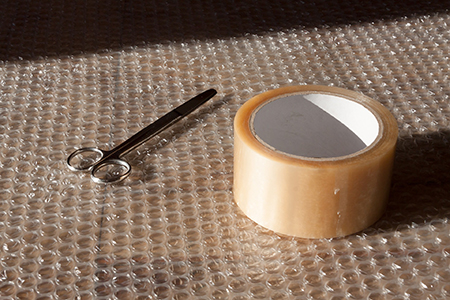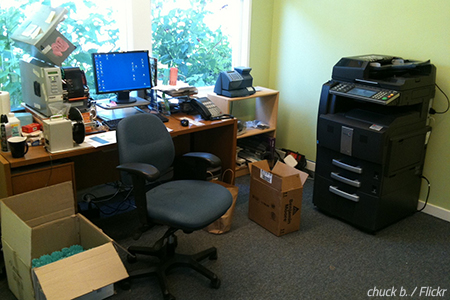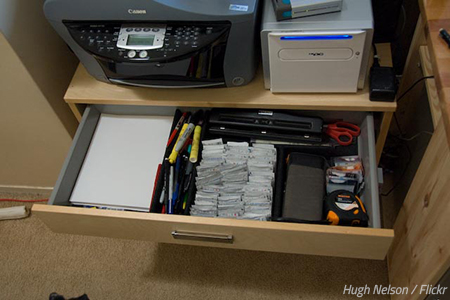How to Pack a Home Office for Moving
The top three candidates for the prize Most Difficult Room to Packare the garage, the kitchen and… your home office. The home office? Really?
Yes.
First and foremost, your home office will contain very important documents that you just can’t afford to lose. Also, there are books to be found in almost any home office room, and books can be extremely heavy when packed into boxes.
Secondly, your home office will also have expensive electronic equipment – computers, monitors, printers, scanners, copiers, desktop phones, Wi-Fi routers, etc. So, how should you pack all those pieces of office equipment to survive the move with zero damage?
And thirdly, you should definitely not underestimate the process of packing and moving your office furniture – desks, chairs, bookcases, file cabinets, drawers, and so on. Will you be able to pack your office furniture by yourself?
Read the home office packing tips below to have a clear idea of what it takes to pack your home office properly and efficiently.
Get the right type of packing supplies
Packing a home office can be rather tricky due to all the important and expensive items found in it. To be able to provide the necessary protection for your sensitive documents, office equipment, and office furniture, you’re going to need to prepare the right packing materials well in advance.
Here’s a list of the home office packing supplies you’ll need:
Strong cardboard boxes
One thing is clear – you can’t pack up your home office without the convenience of sturdy cardboard boxes of various sizes. The good news here is that you don’t have to use only brand-new boxes purchased from an office supply store or from a local moving company.
If you’ve got some time to spare, it’s best for your budget to get moving boxes for free – either by asking friends, coworkers, and neighbors for any cardboard boxes they don’t need, or by checking with local businesses for any leftover cardboard containers.
When packing your home office equipment, you should use the original packing boxes that the electronic devices came in as they provide the best possible protection on the road. Hopefully, you’ll keep those original packaging somewhere, possibly stacked inside your storage room. If you don’t, then you’ll just have to find strong boxes of similar sizes and use much more protective packing materials than you would when using the original boxes.
Packing paper
Packing up your home office efficiently will require plenty of packing paper as well. You’ll need clean, soft, white and ink-free newsprint to protect all the fragile items in your home office such as the pieces of electronic equipment. Never use newspapers to pack up the items in your office because the ink can transfer to some of the more delicate surfaces and ruin your valuable things forever.
A pack of 200 sheets of packing paper costs around $10 and can be bought online or from an office supply store.
Bubble wrap

Bubble wrap will be very useful when you’re packing the electronics and furniture in your home office.
Bubble wrap provides the best protection for all fragile items found in your home office – from delicate sections of home office furniture (glass panels, glass doors, etc.) to the easily breakable electronics inside the office. The air-filled bubbles serve as soft cushions to safeguard those fragile things from the dangers on the road.
One big pack of bubble wrap – small bubble size (150 feet) or large bubble size (100 feet) – costs around $20 and should be enough for packing a home office.
Packing tape and markers for labeling
Don’t just buy the cheapest packing tape you can find – instead, pay a few extra dollars to get several rolls of high-quality packaging tape that’ll do a good job of fixing all protective materials and securing your moving boxes.
When it comes to markers, you’ll probably have a few decent ones lying around in the home office somewhere. As long as a marker is good for labeling your boxes, then it’s good enough to be used for the home office packing job.
How to pack home office documents and paperwork
Every home office contains tons of important documents, so this is what you should do next – organize and pack your home office documents.
Follow the next 5 steps for packing up your paperwork before your move:
Step 1. Sort through your documents
According to one of the fundamental rules when packing for a move, there’s no use in packing up and moving stuff that you’ll only end up throwing away after the move is over.
To avoid doing things that make no sense, your first step to moving your home office is to go through your accumulated documentation and sort it out in three different categories: PACK, SHRED, and RECYCLE.
Step 2. Discard no longer needed documents
You’ll probably find many outdated and unnecessary documents while sorting through your paperwork – don’t waste time packing and moving those. The solution is easy enough: SHRED all unnecessary documents that contain confidential information and RECYCLEthe rest of the useless documentation.
Step 3. Pack the remaining documents
Once you’re left with nothing but important documents which you just have to take with you, your next step is to organize them using a system that works for you. Then, place those essential documents in separate (accordion) folders and pack them in file boxes.
You can use common copy paper boxes to pack your home office documentation if you don’t have any specialized file boxes.
Step 4. Label properly your file boxes

Sort out your office documents before packing them.
After you’ve packed a box with essential documents, tape the lid shut and label it appropriately with a brief description of its contents. Also, write down HOME OFFICE on those boxes so that you’ll know where to take them right after you move into the new home.
Step 5. Move your home office documents by yourself
If you’ve hired a moving company to help you move your belongings, then keep in mind that the important documents, including confidential ones, should stay with you at all times.
Move the home office documentation in your car simply because it’s too risky to hand over any sensitive information to your movers, even when those professionals seem trustworthy and reliable.
How to pack books when moving your home office
There’s a good chance that your home office will contain a good number of books which you would like to move to the new home office in the destination home. But before you can transport those books, you’re going to have to pack them safely for the road ahead.
Follow these simple 5 steps to packing your home office books quickly and safely:
Step 1. Optimize the number of your books
Go through your book collection to see if there are any books you don’t have to pack and move at all. Some books become obsolete with time so it’s always a good idea to review what you have and discard the ones you won’t ever need again.
Do this with all the books in your home, not only the ones in your home office. Be practical – you don’t want to pay money to transport items that you don’t care about anymore.
Step 2. Prepare the book packing boxes
One thing to remember when packing books is that they can become too heavy too quickly. Don’t be fooled by the weightlessness of a single page. Instead, prepare small to medium-sized packing boxes and inspect them for any signs of damage.
To make things safer, tape the bottom of each box you plan to use for packing books to prevent accidental breakage of the containers due to the significant weight.
Finally, place a couple of sheets of packing paper on the inside bottom of each box as extra protection for your books.
Step 3. Arrange the books in the boxes
Start transferring your home office books into the boxes you’ve just prepared. Depending on the sizes and thickness of the books, you can choose to pack them up in 3 distinct ways:
- Arrange the books flat and stack them tightly along the box sides;
- Arrange your books upright so that their open parts are facing the box sides;
- Position the books so that their open parts are facing you. NEVER pack your books with their spines facing you – if you do, you risk getting their bindings damaged during transit.

You’ve just finished packing your home office books. Now it’s bookcase time!
If you happen to own very valuable books, make sure you wrap each copy in white packing paper first.
Step 4. Observe simple safety measures
Remember that books are heavier than they look, so you should try to keep each book box below 50 pounds to keep things safe on the day of the move. As mentioned above, you should also tape the bottom of each box as an extra safety measure.
Here’s one piece of home office packing advice that can be extremely useful for you: if you have a rolling suitcase in your home, consider filling it up with the heaviest books you own.
Step 5. Label the book boxes
Don’t forget to label your boxes for easier identification after the move. Use a marker pen and write BOOKS, then HOME OFFICE – this way, all those book-filled boxes will reappear, as if by magic, in the home office in the new residence.
How to pack your office equipment (electronics)
Of course, our tips for packing your home office will also include some useful advice on how to pack electronics for moving – after all, your office should be crammed with electronic devices of all sort: laptops, desktop computers, monitors, printers, copiers, desktop phones and so on.
All electronic devices are expensive – some more than others, of course, so your priority is to make sure all of them are well-protected for the relocation journey.
Step 1. Keep all wires and cables organized
There’ll be of wires and cables going in and out of each electronic device, which means there will be so many cords to handle when packing your home office for a move. There are basically 3 things you should do to avoid headaches when trying to figure out which cable goes where after the move.
- Take photos of how each device is wired up – a single photo can save you valuable post-move time when you need to hook up your electronics once more.
- Use stickers, colored tape or numbered tags to distinguish between the various cables and even write notes on those stickers whenever necessary – for example, “R” for right, “L” for left, and so on.
- Use zip ties to bundle together similar cables for better organization and easier identification after the move. Pack all cables together with their respective devices.
Step 2. Prepare the right type of boxes
As mentioned earlier, you should use, whenever possible, the original boxes for your electronics. The reason is easy to guess – an original box offers the optimal protection for the device it’s been custom-made to protect during transport. So, if you keep all or most original electronics packaging, then that’s great news.
If you don’t, then don’t worry – you can still make it work by finding thick-walled cardboard boxes of similar size and using generous padding of packing paper and bubble wrap.
Step 3. Back up all important data
Anything can happen during a home move so you must protect all super important electronic work files in case of some sort of transportation damage to your computer, for example.
Guarantee a peace of mind by backing up all essential computer files to a portable flash drive or an external hard drive. To make things even safer, consider using an online backup service such as Google Drive, Dropbox or Microsoft Azure to copy your most critical electronic data.
Step 4. Use plenty of padding when packing home office electronics
Unless you’ve managed to find the original boxes of the electronic devices in the office, you’re going to have to use a great number of padding materials to protect your expensive home office items inside the non-original cardboard boxes.
 Packing your home office equipment is easier when you know what to do.Place pieces of bubble wrap on the bottom of each cardboard box – that initial layer will serve as a shock absorber.
Packing your home office equipment is easier when you know what to do.Place pieces of bubble wrap on the bottom of each cardboard box – that initial layer will serve as a shock absorber.- Place cardboard cut-outs over monitor screens or other very sensitive parts of your office equipment.
- Wrap each electronic device in soft packing paper first, then use sheets of (anti-static) bubble wrap as the final layer. Use small pieces of packing tape to keep everything tight. Do not let bubble wrap touch computer screens directly.
- Use your well-padded laptop bag to move your laptop computer safely to the new home. Don’t forget to pack the AC adapter as well.
Step 5. Label all home office equipment boxes
Again, labeling your boxes properly will save you valuable time after the move, so just do it.
How to pack office furniture when moving
The most efficient way to pack up and move your office space is to take care of the furniture pieces inside it as well.
Our office moving checklist concludes with some tips for packing home office furniture – the last step to moving your home office – last but definitely not least in terms of importance.
Step 1. Decision time: move your office furniture or not?
Before you rush to pack your office furniture for a move, ask yourself if it makes sense under your specific circumstances. Most furniture pieces are rather heavy and their transportation to a new home will cost you a lot, especially if that new home is located a long way from your current location.
Sometimes the more budget-friendly approach is to leave the old furniture pieces behind (or sell it) and purchase new ones after the move is over. Do you really love your office furniture so much that you’re willing to pay good money to move it across the country?
Unless you own a piece infused with sentimental value or an expensive antique furniture piece made of solid wood, most furniture will not be worth moving, even more so when it is of the IKEA type.
Step 2. Disassemble your office furniture

Stretch-wrap drawers, still full of miscellaneous office items, to save precious time.
Step 2 of the office packing checklist is crucial – you’re going to have to disassemble the office furniture pieces that are too big to be packed and moved as they are. This step is meant for desks, bookcases, and file cabinets rather than office chairs and small office furniture that can be moved around easily and safely.
If you’re not sure how to disassemble your office furniture safely, then consult their specific assembly instructions (if applicable) or find somebody who knows what they are doing. Your safest option is still to bet on professional furniture movers.
However, if you do have an idea of what to do, then get your box of hand tools and get down to work. Remember to place small fastening elements such as screws, bolts, nuts, dowels, etc. in sealable plastic bags to keep them from getting lost or misplaced.
Step 3. Pack your disassembled office furniture pieces
- Wrap each disassembled furniture piece in thick (furniture) blankets to protect them from damage.
- Pay special attention to extra fragile areas such as glass components – pack those in packing paper first, then use bubble wrap as an effective cushioning material and finally, wrap them up in blankets.
- Choose to leave miscellaneous small items in their drawers as they are, without removing them and packing them separately. All you need to do is wrap up the entire drawer in stretch wrap and you’re all set.
- Don’t use packing tape or bubble wrap directly onto the surfaces of your office furniture pieces. If you do, then you may ruin a furniture set due to the nasty marks tape and plastic can leave on the delicate outer coats of finish.
Even though packing a home office for a move is not overly complicated, you may still need to get professional assistance, especially if you’re moving in a hurry or you can’t seem to handle the large furniture in your home office. Fill in a free quote to check how much professional movers will charge you for the job.


Comments
Post a Comment